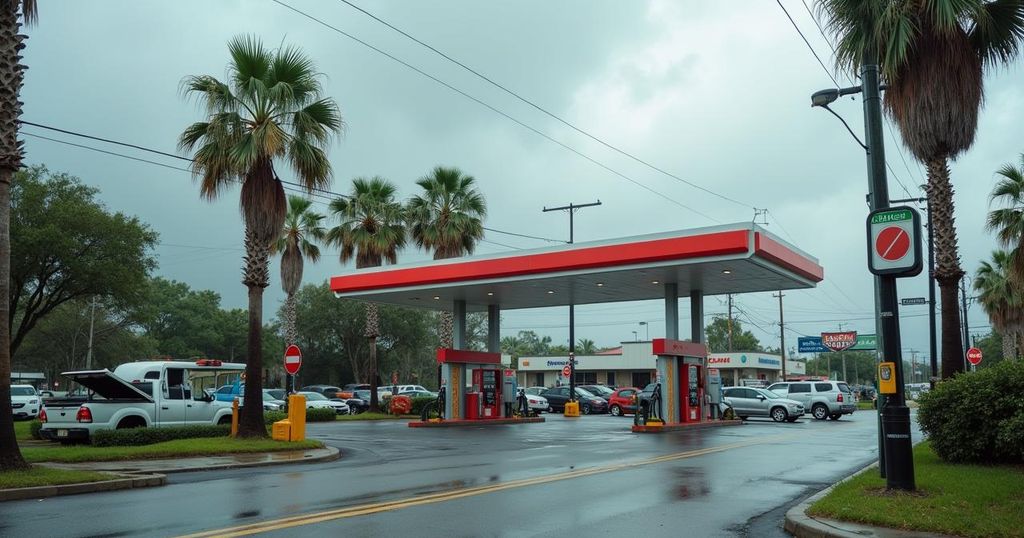Florida Fuel Shortage Amid Recovery from Hurricane Milton
Florida is currently facing a fuel shortage following Hurricane Milton, which has caused extensive damage and prompted long wait times at gas stations. Governor Ron DeSantis has initiated measures to distribute fuel and aid recovery efforts. As residents return home, they are confronted with significant destruction, leading to community-wide clean-up efforts. President Biden plans to visit the region to survey the damage and discuss funding needs for recovery.
Florida residents are grappling with a fuel shortage as they attempt to recover from the devastation caused by Hurricane Milton. Long lines have formed at gas stations across the state as people, many of whom evacuated from their homes, seek gasoline urgently. In St. Petersburg, Daniel Thornton and his daughter Magnolia waited eagerly at a station that had run out of fuel, remaining hopeful that supplies would arrive soon. “They told me they have gas coming but they don’t know when it’s going to be here,” he expressed, emphasizing the need for patience despite their predicament. In response to the crisis, Governor Ron DeSantis announced the establishment of multiple fuel distribution sites, where residents could receive 10 gallons of fuel at no cost. “Obviously as power gets restored … and the Port of Tampa is open, you’re going to see the fuel flowing. But in the meantime, we want to give people another option,” he stated, assuring the public that efforts were underway to stabilize fuel supplies. As individuals return to their homes, they are confronted with significant damage from the dual hurricanes, with many beginning the difficult task of clean-up. Bill O’Connell remarked on the extensive damage sustained at Bahia Vista Gulf due to Hurricane Milton. “It reflooded everything that was already flooded, brought all the sand back on our property that we removed,” he lamented, highlighting the added burden of recovery. The situation remains dire in several communities, such as the fishing village of Cortez, where residents are working to clear their properties of debris while assessing the extensive damage left behind. “Everything is shot,” said Mark Praught, a longtime resident, as he described the impacts on his home. Nature’s destruction has hit twice, leaving many families overwhelmed and in distress. Catherine Praught voiced the sentiments shared by many, saying, “This is where we live. We’re just hopeful we get the insurance company to help us.” President Joe Biden plans to visit the impacted regions to survey the destruction and is expected to discuss funding needs with Governor DeSantis amidst efforts to secure assistance for hurricane recovery. With estimated losses ranging from $50 billion to $85 billion according to Moody’s Analytics, the magnitude of the disaster is apparent as the state faces recovery challenges. As Floridians work through safety threats from flooding and ongoing power outages, individuals are reminded to exercise caution. Poweroutage.us reported approximately 1.3 million residents remained without power following the storm, as National Weather Service Meteorologist Paul Close warned of continued rising rivers in the region for several days. While the forecast offers a respite from rain, the pathway to recovery remains complex and fraught with challenges.
The article provides insight into the aftermath of Hurricane Milton, detailing the struggles Floridians face in securing fuel amidst a shortage, which has been exacerbated by the storm’s devastation. The hurricane not only impacted fuel supply but also left extensive property damage, prompting residents to return home to begin the recovery process. The economic implications of the storm are significant, with estimates suggesting total costs could reach into the billions. Governor Ron DeSantis and President Joe Biden are involved in addressing these issues as aid is coordinated.
In summary, Florida continues to navigate the challenges posed by Hurricane Milton, characterized by a critical fuel shortage and extensive property damage. Residents are uniting to assist one another as they begin recovery efforts, while state and federal officials work to ensure that support structures are in place. The path ahead involves overcoming logistical obstacles and securing necessary funding and assistance to facilitate the restoration of affected communities.
Original Source: fortune.com




Post Comment